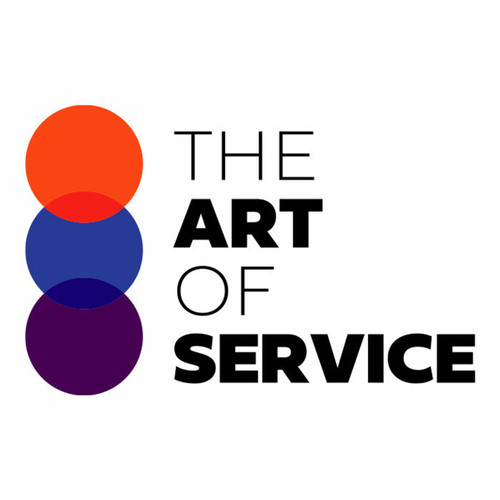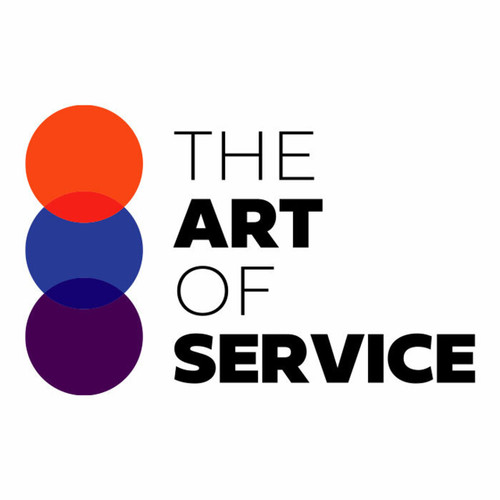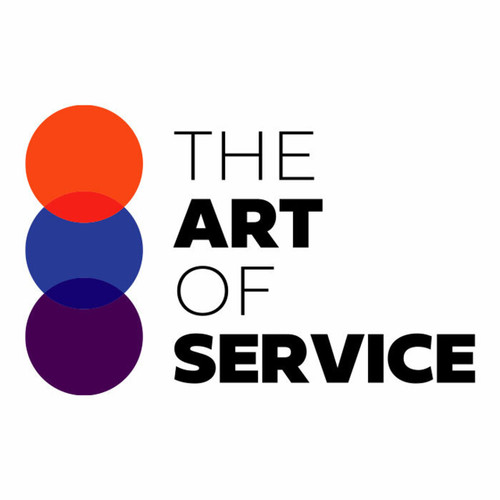Our Data Management and Data Obsolescence Knowledge Base is here to help.
Our dataset consists of 1502 prioritized requirements, solutions, benefits, results, and case studies all related to Data Management and Data Obsolescence.
We have carefully curated and organized this information to provide you with the most comprehensive and up-to-date knowledge on this topic.
What sets our Knowledge Base apart from competitors and alternatives is its focus on urgency and scope.
We understand that tackling data management and obsolescence can be overwhelming, which is why we have provided a list of the most important questions to ask to get results quickly and effectively.
This product is designed for professionals in any industry who deal with managing and maintaining data.
Whether you are new to this field or have years of experience, our Knowledge Base will help you stay ahead of the game and make informed decisions.
Our product is versatile and easy to use.
It comes in a DIY format, making it affordable for individuals and small businesses alike.
You can easily navigate through the dataset and find the specific information you need with just a few clicks.
But don′t just take our word for it.
Our dataset is backed by thorough research and includes real-life case studies and use cases.
This means that you can trust the information provided and apply it to your own data management strategies with confidence.
Businesses of all sizes can benefit from our Data Management and Data Obsolescence Knowledge Base.
It is a cost-effective solution compared to hiring expensive consultants or investing in complicated software.
Plus, our dataset is regularly updated, so you′ll always have access to the latest information.
We understand that every product has its pros and cons.
However, with our Knowledge Base, the pros far outweigh the cons.
By utilizing our dataset, you′ll save time, money, and effort in managing your data, leading to increased efficiency and productivity.
So, what exactly does our product do? It provides you with a comprehensive overview of Data Management and Data Obsolescence, including solutions to common problems, benefits of proper data management, and results you can expect to achieve.
In short, our Knowledge Base is the ultimate guide to help you effectively manage and maximize your data.
Don′t miss out on this valuable resource.
Take control of your data management and obsolescence today with our Knowledge Base.
Order now and see the difference it can make for yourself!
Discover Insights, Make Informed Decisions, and Stay Ahead of the Curve:
Key Features:
Comprehensive set of 1502 prioritized Data Management requirements. - Extensive coverage of 110 Data Management topic scopes.
- In-depth analysis of 110 Data Management step-by-step solutions, benefits, BHAGs.
- Detailed examination of 110 Data Management case studies and use cases.
- Digital download upon purchase.
- Enjoy lifetime document updates included with your purchase.
- Benefit from a fully editable and customizable Excel format.
- Trusted and utilized by over 10,000 organizations.
- Covering: Backup And Recovery Processes, Data Footprint, Data Architecture, Obsolete Technology, Data Retention Strategies, Data Backup Protocols, Migration Strategy, Data Obsolescence Costs, Legacy Data, Data Transformation, Data Integrity Checks, Data Replication, Data Transfer, Parts Obsolescence, Research Group, Risk Management, Obsolete File Formats, Obsolete Software, Storage Capacity, Data Classification, Total Productive Maintenance, Data Portability, Data Migration Challenges, Data Backup, Data Preservation Policies, Data Lifecycles, Data Archiving, Backup Storage, Data Migration, Legacy Systems, Cloud Storage, Hardware Failure, Data Modernization, Data Migration Risks, Obsolete Devices, Information Governance, Outdated Applications, External Processes, Software Obsolescence, Data Longevity, Data Protection Mechanisms, Data Retention Rules, Data Storage, Data Retention Tools, Data Recovery, Storage Media, Backup Frequency, Disaster Recovery, End Of Life Planning, Format Compatibility, Data Disposal, Data Access, Data Obsolescence Planning, Data Retention Standards, Open Data Standards, Obsolete Hardware, Data Quality, Product Obsolescence, Hardware Upgrades, Data Disposal Process, Data Ownership, Data Validation, Data Obsolescence, Predictive Modeling, Data Life Expectancy, Data Destruction Methods, Data Preservation Techniques, Data Lifecycle Management, Data Reliability, Data Migration Tools, Data Security, Data Obsolescence Monitoring, Data Redundancy, Version Control, Data Retention Policies, Data Backup Frequency, Backup Methods, Technology Advancement, Data Retention Regulations, Data Retrieval, Data Transformation Tools, Cloud Compatibility, End Of Life Data Management, Data Remediation, Data Obsolescence Management, Data Preservation, Data Management, Data Retention Period, Data Legislation, Data Compliance, Data Migration Cost, Data Storage Costs, Data Corruption, Digital Preservation, Data Retention, Data Obsolescence Risks, Data Integrity, Data Migration Best Practices, Collections Tools, Data Loss, Data Destruction, Cloud Migration, Data Retention Costs, Data Decay, Data Replacement, Data Migration Strategies, Preservation Technology, Long Term Data Storage, Software Migration, Software Updates
Data Management Assessment Dataset - Utilization, Solutions, Advantages, BHAG (Big Hairy Audacious Goal):
Data Management
Data management is the organization and manipulation of data to adapt and meet the demands of the ever-changing business landscape.
1. Regular data backups and migrations ensure accessibility of data in case of obsolescence.
2. Adoption of cloud storage for easy access and management of data.
3. Implementing data archiving techniques to store legacy data for long-term retention.
4. Implementation of data governance policies to manage and control the quality of data.
5. Use of data virtualization to access and integrate data from multiple sources without physical database changes.
6. Continuous monitoring and updating of technology and tools used for managing data.
7. Collaboration with IT experts and consultants to keep up with the latest data management strategies.
8. Developing a data lifecycle management plan to identify and handle obsolete data.
9. Utilizing data cleansing techniques to eliminate irrelevant and duplicate data.
10. Leveraging data analytics tools for better utilization and understanding of data.
CONTROL QUESTION: Are the processes Transformed to take on the current competitive environment?
Big Hairy Audacious Goal (BHAG) for 10 years from now:
By 2031, our company will have completely transformed its data management processes to be agile, adaptable, and data-driven in order to successfully compete in the rapidly evolving competitive landscape. We will have leveraged cutting-edge technologies such as artificial intelligence and machine learning, and established robust data governance standards to ensure the security, accuracy, and accessibility of our data. Our employees will have undergone extensive training to become skilled in utilizing data to drive decision-making and innovation across all departments. This transformation will position us as a leader in data management and allow us to stay ahead of our competitors by quickly responding to market changes and delivering superior customer experiences.
Customer Testimonials:
"This dataset is a game-changer for personalized learning. Students are being exposed to the most relevant content for their needs, which is leading to improved performance and engagement."
"I`ve recommended this dataset to all my colleagues. The prioritized recommendations are top-notch, and the attention to detail is commendable. It has become a trusted resource in our decision-making process."
"I`ve tried several datasets before, but this one stands out. The prioritized recommendations are not only accurate but also easy to interpret. A fantastic resource for data-driven decision-makers!"
Data Management Case Study/Use Case example - How to use:
Introduction:
The dynamic and rapidly changing business environment has forced organizations to continuously evaluate and improve their processes in order to remain competitive. Technology advancements, globalization and evolving consumer demands are just a few factors that have contributed to this ever-changing landscape. In such a scenario, data has emerged as a valuable asset for organizations to gain insights into their operations and make informed decisions. However, the challenge lies in effectively managing and utilizing this data to drive business growth and success.
This case study focuses on a consulting project for a mid-sized retail company, which was struggling to adapt its data management processes to the current competitive environment. The client′s core business revolved around selling apparel and accessories in physical stores and online. With the rise of e-commerce and digitalization, the client faced intense competition from larger retail players and online retailers. The increasing pressure to offer personalized and seamless customer experiences further added to their woes.
Synopsis of Client Situation:
The client recognized the need to modernize their data management processes to keep up with the evolving business landscape. Their current data management system was outdated, with disconnected systems and manual processes leading to data silos and an inefficient flow of information across the organization. This resulted in a lack of real-time visibility into customer behavior and preferences, hindering the client′s ability to make data-driven decisions.
Consulting Methodology:
To address the client′s challenges, our consulting firm followed a step-by-step approach, as outlined below:
1. Assessment: The first step involved assessing the client′s current data management processes, systems, and workflows. This included interviews with key stakeholders, evaluation of existing data governance policies and procedures, and a review of data quality and integrity.
2. Gap Analysis: Based on the assessment, a gap analysis was conducted to identify the shortcomings in the current processes and systems, along with potential areas for improvement.
3. Solution Design: Leveraging our expertise in data management and emerging technologies, our team designed a comprehensive data management strategy that aligned with the client′s business objectives and addressed the identified gaps.
4. Implementation: The proposed solution was implemented in phases, starting with the integration of disparate data systems and streamlining of data flows. This was followed by the implementation of a master data management system and the establishment of data governance policies and procedures.
5. Training and Change Management: To ensure the client′s teams were equipped to make the most of the new data management system, our consultants provided training on data analytics, visualization, and interpretation. We also worked closely with the client′s teams to drive organizational change management, promoting a data-driven culture within the company.
Deliverables:
The deliverables of the project included:
1. A detailed assessment report highlighting the current state of the client′s data management processes and systems, along with recommendations for improvement.
2. A comprehensive data management strategy outlining the roadmap for modernizing the client′s data processes.
3. A master data management system that integrated multiple sources of data and provided a single view of customer data.
4. Data governance policies and procedures for ensuring data quality and integrity.
5. Training materials and sessions for upskilling the client′s teams in data analytics and visualization.
6. Change management activities such as workshops and communication plans to promote a data-driven culture within the organization.
Implementation Challenges:
The main challenges faced during the implementation of the project were related to data integration and change management. The client had multiple legacy systems and data sources, making it a complex task to integrate and cleanse the data. Additionally, resistance to change from some employees who were used to manual processes posed a challenge when implementing the new data management system and driving a data-driven culture.
KPIs and Other Management Considerations:
To measure the success of the project, the following KPIs were identified and tracked:
1. Increase in data accuracy and completeness.
2. Reduction in data silos and improved data integration.
3. Increase in the speed and efficiency of data processing and analytics.
4. Improved customer service due to a single view of customer data.
5. Increase in sales and revenue through targeted and personalized marketing strategies.
6. Reduction in operational costs due to streamlining of data processes.
7. Employee adoption and usage of the new data management system.
Management considerations included establishing a data governance board to oversee the implementation and adoption of data governance policies, regular data quality audits, and continuous training and upskilling of employees to keep up with emerging data management technologies and best practices.
Conclusion:
Through our consulting project, the client was able to transform their data management processes to take on the current competitive environment. The implementation of a robust data management strategy and system enabled the client to gain real-time insights into their operations, customer behavior, and market trends, thereby making informed decisions. The success of this project highlights the importance of continuously evaluating and optimizing data management processes to remain competitive in today′s business landscape.
References:
1. Gartner, Data Management for Competitive Advantage, March 2020.
2. Harvard Business Review, Becoming a Data-Driven Organization, October 2012.
3. McKinsey & Company, The Power of Artificial Intelligence in Retail, November 2019.
4. Forbes Insights, The Competitive Edge of Data and Analytics, July 2018.
5. Deloitte, Mastering Data Management: From Data Governance to Effective Decision-Making, November 2019.
Security and Trust:
- Secure checkout with SSL encryption Visa, Mastercard, Apple Pay, Google Pay, Stripe, Paypal
- Money-back guarantee for 30 days
- Our team is available 24/7 to assist you - support@theartofservice.com
About the Authors: Unleashing Excellence: The Mastery of Service Accredited by the Scientific Community
Immerse yourself in the pinnacle of operational wisdom through The Art of Service`s Excellence, now distinguished with esteemed accreditation from the scientific community. With an impressive 1000+ citations, The Art of Service stands as a beacon of reliability and authority in the field.Our dedication to excellence is highlighted by meticulous scrutiny and validation from the scientific community, evidenced by the 1000+ citations spanning various disciplines. Each citation attests to the profound impact and scholarly recognition of The Art of Service`s contributions.
Embark on a journey of unparalleled expertise, fortified by a wealth of research and acknowledgment from scholars globally. Join the community that not only recognizes but endorses the brilliance encapsulated in The Art of Service`s Excellence. Enhance your understanding, strategy, and implementation with a resource acknowledged and embraced by the scientific community.
Embrace excellence. Embrace The Art of Service.
Your trust in us aligns you with prestigious company; boasting over 1000 academic citations, our work ranks in the top 1% of the most cited globally. Explore our scholarly contributions at: https://scholar.google.com/scholar?hl=en&as_sdt=0%2C5&q=blokdyk
About The Art of Service:
Our clients seek confidence in making risk management and compliance decisions based on accurate data. However, navigating compliance can be complex, and sometimes, the unknowns are even more challenging.
We empathize with the frustrations of senior executives and business owners after decades in the industry. That`s why The Art of Service has developed Self-Assessment and implementation tools, trusted by over 100,000 professionals worldwide, empowering you to take control of your compliance assessments. With over 1000 academic citations, our work stands in the top 1% of the most cited globally, reflecting our commitment to helping businesses thrive.
Founders:
Gerard Blokdyk
LinkedIn: https://www.linkedin.com/in/gerardblokdijk/
Ivanka Menken
LinkedIn: https://www.linkedin.com/in/ivankamenken/







